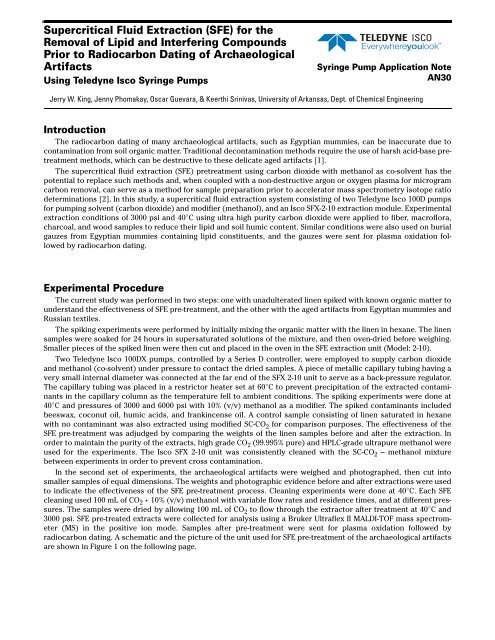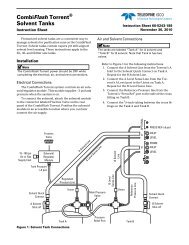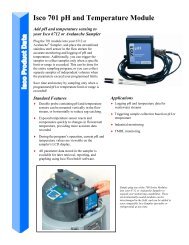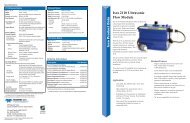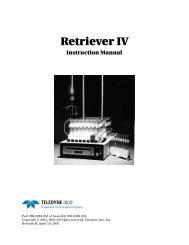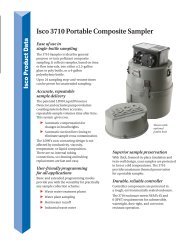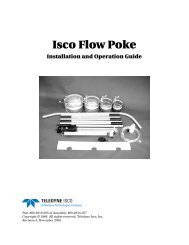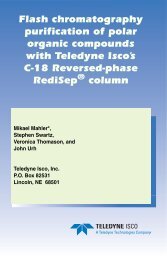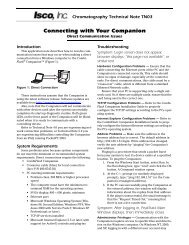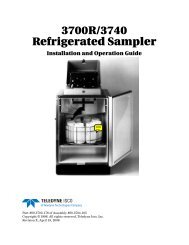Supercritical Fluid Extraction (SFE) for the Removal of Lipid ... - Isco
Supercritical Fluid Extraction (SFE) for the Removal of Lipid ... - Isco
Supercritical Fluid Extraction (SFE) for the Removal of Lipid ... - Isco
- No tags were found...
You also want an ePaper? Increase the reach of your titles
YUMPU automatically turns print PDFs into web optimized ePapers that Google loves.
<strong>Supercritical</strong> <strong>Fluid</strong> <strong>Extraction</strong> (<strong>SFE</strong>) <strong>for</strong> <strong>the</strong><strong>Removal</strong> <strong>of</strong> <strong>Lipid</strong> and Interfering CompoundsPrior to Radiocarbon Dating <strong>of</strong> ArchaeologicalArtifactsUsing Teledyne <strong>Isco</strong> Syringe PumpsSyringe Pump Application NoteAN30Jerry W. King, Jenny Phomakay, Oscar Guevara, & Keerthi Srinivas, University <strong>of</strong> Arkansas, Dept. <strong>of</strong> Chemical EngineeringIntroductionThe radiocarbon dating <strong>of</strong> many archaeological artifacts, such as Egyptian mummies, can be inaccurate due tocontamination from soil organic matter. Traditional decontamination methods require <strong>the</strong> use <strong>of</strong> harsh acid-base pretreatmentmethods, which can be destructive to <strong>the</strong>se delicate aged artifacts [1].The supercritical fluid extraction (<strong>SFE</strong>) pretreatment using carbon dioxide with methanol as co-solvent has <strong>the</strong>potential to replace such methods and, when coupled with a non-destructive argon or oxygen plasma <strong>for</strong> microgramcarbon removal, can serve as a method <strong>for</strong> sample preparation prior to accelerator mass spectrometry isotope ratiodeterminations [2]. In this study, a supercritical fluid extraction system consisting <strong>of</strong> two Teledyne <strong>Isco</strong> 100D pumps<strong>for</strong> pumping solvent (carbon dioxide) and modifier (methanol), and an <strong>Isco</strong> SFX-2-10 extraction module. Experimentalextraction conditions <strong>of</strong> 3000 psi and 40°C using ultra high purity carbon dioxide were applied to fiber, macr<strong>of</strong>lora,charcoal, and wood samples to reduce <strong>the</strong>ir lipid and soil humic content. Similar conditions were also used on burialgauzes from Egyptian mummies containing lipid constituents, and <strong>the</strong> gauzes were sent <strong>for</strong> plasma oxidation followedby radiocarbon dating.Experimental ProcedureThe current study was per<strong>for</strong>med in two steps: one with unadulterated linen spiked with known organic matter tounderstand <strong>the</strong> effectiveness <strong>of</strong> <strong>SFE</strong> pre-treatment, and <strong>the</strong> o<strong>the</strong>r with <strong>the</strong> aged artifacts from Egyptian mummies andRussian textiles.The spiking experiments were per<strong>for</strong>med by initially mixing <strong>the</strong> organic matter with <strong>the</strong> linen in hexane. The linensamples were soaked <strong>for</strong> 24 hours in supersaturated solutions <strong>of</strong> <strong>the</strong> mixture, and <strong>the</strong>n oven-dried be<strong>for</strong>e weighing.Smaller pieces <strong>of</strong> <strong>the</strong> spiked linen were <strong>the</strong>n cut and placed in <strong>the</strong> oven in <strong>the</strong> <strong>SFE</strong> extraction unit (Model: 2-10).Two Teledyne <strong>Isco</strong> 100DX pumps, controlled by a Series D controller, were employed to supply carbon dioxideand methanol (co-solvent) under pressure to contact <strong>the</strong> dried samples. A piece <strong>of</strong> metallic capillary tubing having avery small internal diameter was connected at <strong>the</strong> far end <strong>of</strong> <strong>the</strong> SFX 2-10 unit to serve as a back-pressure regulator.The capillary tubing was placed in a restrictor heater set at 60°C to prevent precipitation <strong>of</strong> <strong>the</strong> extracted contaminantsin <strong>the</strong> capillary column as <strong>the</strong> temperature fell to ambient conditions. The spiking experiments were done at40°C and pressures <strong>of</strong> 3000 and 6000 psi with 10% (v/v) methanol as a modifier. The spiked contaminants includedbeeswax, coconut oil, humic acids, and frankincense oil. A control sample consisting <strong>of</strong> linen saturated in hexanewith no contaminant was also extracted using modified SC-CO 2 <strong>for</strong> comparison purposes. The effectiveness <strong>of</strong> <strong>the</strong><strong>SFE</strong> pre-treatment was adjudged by comparing <strong>the</strong> weights <strong>of</strong> <strong>the</strong> linen samples be<strong>for</strong>e and after <strong>the</strong> extraction. Inorder to maintain <strong>the</strong> purity <strong>of</strong> <strong>the</strong> extracts, high grade CO 2 (99.995% pure) and HPLC-grade ultrapure methanol wereused <strong>for</strong> <strong>the</strong> experiments. The <strong>Isco</strong> SFX 2-10 unit was consistently cleaned with <strong>the</strong> SC-CO 2 – methanol mixturebetween experiments in order to prevent cross contamination.In <strong>the</strong> second set <strong>of</strong> experiments, <strong>the</strong> archaeological artifacts were weighed and photographed, <strong>the</strong>n cut intosmaller samples <strong>of</strong> equal dimensions. The weights and photographic evidence be<strong>for</strong>e and after extractions were usedto indicate <strong>the</strong> effectiveness <strong>of</strong> <strong>the</strong> <strong>SFE</strong> pre-treatment process. Cleaning experiments were done at 40°C. Each <strong>SFE</strong>cleaning used 100 mL <strong>of</strong> CO 2 + 10% (v/v) methanol with variable flow rates and residence times, and at different pressures.The samples were dried by allowing 100 mL <strong>of</strong> CO 2 to flow through <strong>the</strong> extractor after treatment at 40°C and3000 psi. <strong>SFE</strong> pre-treated extracts were collected <strong>for</strong> analysis using a Bruker Ultraflex II MALDI-TOF mass spectrometer(MS) in <strong>the</strong> positive ion mode. Samples after pre-treatment were sent <strong>for</strong> plasma oxidation followed byradiocarbon dating. A schematic and <strong>the</strong> picture <strong>of</strong> <strong>the</strong> unit used <strong>for</strong> <strong>SFE</strong> pre-treatment <strong>of</strong> <strong>the</strong> archaeological artifactsare shown in Figure 1 on <strong>the</strong> following page.
Syringe Pump Application Note AN30Figure 1: Photo and Schematic <strong>of</strong> <strong>the</strong> <strong>Supercritical</strong><strong>Fluid</strong> Cleaning <strong>of</strong> Archaeological ArtifactsResults and DiscussionAs indicated earlier, <strong>the</strong> spiking experiments weredone to study <strong>the</strong> efficacy <strong>of</strong> modified supercritical CO 2in removing certain contaminants from <strong>the</strong> archaeologicalartifacts. The spiking experiments indicated thatsupercritical CO 2 modified with 10% (v/v) methanolremoved <strong>the</strong> beeswax, coconut oil, and humic acidsfrom linen. There was no significant effect <strong>of</strong> pressure on<strong>the</strong> removal <strong>of</strong> coconut oil and beeswax from linen, butmore humic acids were removed at a pressure <strong>of</strong> 6000psi when compared with that at 3000 psi. This removal<strong>of</strong> humic acids from linen was not complete at <strong>the</strong>higher pressure, since <strong>the</strong>re were still traces <strong>of</strong> humicacid left behind in <strong>the</strong> cell and in <strong>the</strong> linen samples afterextraction. Gravimetric analysis indicated that at 40°Cand 6000 psi, modified SC-CO 2 was capable <strong>of</strong> removingabout 25.2% beeswax, 18.4% coconut oil, 5.80% humicacids, and 0.6% frankincense oil (by weight) from <strong>the</strong>respective spiked linen samples.The extracts from <strong>SFE</strong> cleaning <strong>of</strong> <strong>the</strong> Egyptianmummy gauzes and <strong>the</strong> Russian textiles were characterizedwith respect to <strong>the</strong>ir organic constituents.MALDI-TOF spectra mass spectroscopy study <strong>of</strong> <strong>the</strong>Egyptian mummy burial gauzes measured between500-5000 Da, indicating <strong>the</strong> presence <strong>of</strong> a polymer in <strong>the</strong>collected extracts that contain repeating oligomericunits differing by 74 Da, which is characteristic <strong>of</strong> <strong>the</strong>polymer, polyglycerol.In addition, GC/MS analysis (Table 1) showed <strong>the</strong>presence <strong>of</strong> fatty acid moieties as <strong>the</strong>ir methyl esters in<strong>the</strong> Egyptian burial cloths. The fatty acid methyl esters(FAMES) range from C14:0 through C18:3, and arisethrough <strong>the</strong> use <strong>of</strong> vegetable oils and/or wax esters in<strong>the</strong> preparation <strong>of</strong> <strong>the</strong> mummy <strong>for</strong> burial [3]. The occurrence<strong>of</strong> FAME derivatives in <strong>the</strong> SC-CO 2 – methanolextract is indicative <strong>of</strong> possible in-situ reaction between<strong>the</strong> extraction solvent mixture and <strong>the</strong> lipophilic oils in<strong>the</strong> burial gauze. The presence <strong>of</strong> odd- carbon numberedacids is also indicative <strong>of</strong> a ruminant fat beingused in burial preparation. One <strong>of</strong> <strong>the</strong> authors has in <strong>the</strong>past reported in-situ methylation <strong>of</strong> vegetable oilsduring <strong>SFE</strong> [4,5]; o<strong>the</strong>r investigators such as McDaniel etal [6], Wyatt and Haas [7], and o<strong>the</strong>rs [8] cite <strong>the</strong> syn<strong>the</strong>sis<strong>of</strong> FAMEs under supercritical CO 2 in <strong>the</strong> presence<strong>of</strong> methanol. It should be noted that both potash andnatron were widely used by <strong>the</strong> Egyptians—which couldserve as a source <strong>of</strong> alkali metal salts as possible catalysts<strong>for</strong> producing FAMEs. If our rationale is correct,<strong>the</strong>n a number <strong>of</strong> materials associated with archeologicalartifacts could be identified based on <strong>the</strong>irmethylated products [9, 10].
Syringe Pump Application Note AN30Table 1: Database fit from mass spectrophotometric characterization <strong>of</strong> FAMEcontent in Egyptian mummy gauzes extracted with SC-CO 2 modified with 10%(v/v) methanol at 40°C and 3000 psi. (nd = not defined.)Compound T r (min) Child Mummy Child Mummy (2) Bovine MummyC 14:0 20.3 nd 95 ndC 15:0 22.2 95 97 ndC 16:0 24.1 98 99 95C 16:0 (isomer) 24.7 nd nd 72C 18:0 27.5 nd 96 ndC 18:1 28.2 nd 98 ndC 18:2 29.3 nd 98 ndC 18:3 30.6 98 91 ndSimilar experiments per<strong>for</strong>med with <strong>the</strong> Russian textilesamples indicated <strong>the</strong> presence <strong>of</strong> a polymericmoiety in <strong>the</strong> MALDI-TOF spectra with repeating oligomericunits differing by 58 Da. The assignment <strong>of</strong>structure and <strong>the</strong> origin <strong>of</strong> this compound are stillpending. The Russian textile samples were <strong>the</strong>n treatedwith modified SC-CO 2 at 40°C under different pressures<strong>of</strong> 3000, 6000 and 9000 psi, and <strong>the</strong> effectiveness <strong>of</strong> <strong>SFE</strong>cleaning was obtained by gravimetric analysis <strong>of</strong> <strong>the</strong>samples. The efficiency <strong>of</strong> contaminant removal from<strong>the</strong> Russian textiles using modified SC-CO 2 at 40°C wasfound to increase linearly as a function <strong>of</strong> pressure(Figure 2).0.20.16% Weight Removed0.120.08y = 1E-05x + 0.0407R² = 0.97840.0400 2000 4000 6000 8000 10000Pressure (psi)Figure 2: Weight percent <strong>of</strong> organic matter extracted from <strong>the</strong> Russian mummy sample at 3000, 6000 and9000 psi and 40°C using SC-CO 2 modified with 10% (v/v) methanol
Syringe Pump Application Note AN30The a<strong>for</strong>ementioned study indicates that using a mixture<strong>of</strong> supercritical carbon dioxide and methanol iseffective in <strong>the</strong> removal <strong>of</strong> selected organic matter fromvarious archaeological artifacts, <strong>the</strong>reby suggesting thatsupercritical carbon dioxide, modified with an alcoholicsolvent such as methanol, is a viable non-destructivepretreatment prior to plasma oxidation and radiocarbondating <strong>for</strong> an accurate estimation <strong>of</strong> <strong>the</strong> age <strong>of</strong> <strong>the</strong> artifacts.Excellent agreement has been recorded between<strong>the</strong> current pretreatment method (boxes) and those pretreatedusing strong acid or base (circles) applied tovarious archeological artifacts as shown in Figure 3.Figure 3: Radiocarbon dates by pre-treatment with strong acid or base (circles) vs. supercritical pretreatment(boxes)
Syringe Pump Application Note AN30References1. Steelman, K. L. and Rowe, M. W. 2001. Chapter 2 in ArchaeologicalChemistry – Materials, Methods, and Meaning,K.A. Jakes (ed.), American Chemical Society, Washington,DC.2. Steelman, K. L. 2004, Ph.D. Thesis, Department <strong>of</strong> Chemistry,Texas A&M University.3. Proefke, M. L., Reinhart, K. L., Raheel, M., Ambrose, S. H.and Wisseman, S. U. 1992. Probing <strong>the</strong> Mysteries <strong>of</strong>Ancient Egypt. Chemical Analysis <strong>of</strong> Roman Period EgyptianMummy. Anal. Chem., 664, 105-111A.4. King, J. W., France, J. E. and Snyder, J. M. 1992. On-line<strong>Supercritical</strong> <strong>Fluid</strong> <strong>Extraction</strong>-<strong>Supercritical</strong> <strong>Fluid</strong> Reaction-CapillaryGas Chromatography Analysis <strong>of</strong> <strong>the</strong> FattyAcid Composition <strong>of</strong> Oilseeds. Fresenius J. Anal. Chem.,344, 474-478.5. Jackson, M. A. and King, J. W. 1996. Methanolysis <strong>of</strong> SeedOils in Flowing <strong>Supercritical</strong> Carbon Dioxide. J. Am. Oil.Chem. Soc., 73, 353-356.6. McDaniel, L. H., Asharf-Khorassani, M. and Taylor, L. T.2001. <strong>Supercritical</strong> <strong>Fluid</strong> <strong>Extraction</strong> <strong>of</strong> Wood Pulp withAnalysis by Capillary Gas Chromatography-Mass Spectrometry.J. Supercrit. <strong>Fluid</strong>s, 19, 275-286.7. Wyatt, V. T. and Haas, M. J. 2009. Production <strong>of</strong> Fatty AcidMethyl Esters via <strong>the</strong> In Situ Transesterification <strong>of</strong> SoybeanOil in Carbon Dioxide-Expanded Methanol. J. Am. Oil Chem.Soc., 86, 1009-1016.8. West, K. N., Wheeler, C., McCarney, J. P., Griffith, K. N.,Bush, D., Liotta, C. L. and Eckert, C. A. 2001. In Situ Formation<strong>of</strong> Alkylcarbonic Acids with CO2. J. Phys. Chem. A, 105,3947-3948.9. Nicholson, P. T. and Shaw, I. (eds.), 2000. Ancient EgyptianMaterials and Technology, Cambridge University Press,Cambridge, England.10. Colombini, M. R. and Modugno, F. 2009 Organic MassSpectrometry in Art and Archaeology, John Wiley, N.Y.Last modified September 26, 2012Teledyne <strong>Isco</strong>P.O. Box 82531, Lincoln, Nebraska, 68501 USAToll-free: (800) 228-4373 • Phone: (402) 464-0231 • Fax: (402) 465-3091E-mail: <strong>Isco</strong>Info@teledyne.comTeledyne <strong>Isco</strong> is continually improving its products and reserves <strong>the</strong> right to change productspecifications, replacement parts, schematics, and instructions without notice.


